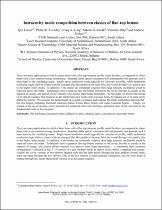JavaScript is disabled for your browser. Some features of this site may not work without it.
- ResearchSpace
- →
- Research Publications/Outputs
- →
- Conference Publications
- →
- View Item
| dc.contributor.author |
Litvin, IA

|
|
| dc.contributor.author |
Loveday, Philip W

|
|
| dc.contributor.author |
Long, Craig S

|
|
| dc.contributor.author |
Kazak, NS

|
|
| dc.contributor.author |
Belyi, V

|
|
| dc.contributor.author |
Forbes, A

|
|
| dc.date.accessioned | 2010-01-06T14:56:04Z | |
| dc.date.available | 2010-01-06T14:56:04Z | |
| dc.date.issued | 2008-08 | |
| dc.identifier.citation | Litvin, IA, Loveday, PW, Long, CS et al. 2008. Intracavity mode competition between classes of flat–top beams. Laser Beam Shaping IX Conference, San Diego, USA, 11 August 2008, pp 1-9 | en |
| dc.identifier.isbn | 9780819477200 | |
| dc.identifier.issn | 0277-786X | |
| dc.identifier.uri | http://hdl.handle.net/10204/3842 | |
| dc.identifier.uri | https://www.spiedigitallibrary.org/conference-proceedings-of-spie/7062/706210/Intracavity-mode-competition-between-classes-of-flat-top-beams/10.1117/12.793686.full | |
| dc.identifier.uri | https://doi.org/10.1117/12.793686 | |
| dc.description | Copyright 2008. Society of Photo-Optical Instrumentation Engineers. One print or electronic copy may be made for personal use only. Systematic reproduction and distribution, duplication of any material in this paper for a fee or for commercial purposes, or modification of the content of the paper are prohibited | en |
| dc.description.abstract | There are many applications in which a laser beam with a flat–top intensity profile would be ideal, as compared to a laser beam with a non–uniform energy distribution. Standard stable optical resonators will unfortunately not generate such a laser beam as the oscillating mode. Single–mode oscillation would typically be Gaussian in profile, while multimode oscillation might deliver a beam with an averaged flat–like profile in the near field, but would diverge very quickly due to the higher order modes. In addition, if the modes are coherently coupled, then large intensity oscillations could be expected across the beam. Techniques exist to generate flat–top beams external to the cavity, but this is usually at the expense of energy, and almost always requires very precise input beam parameters. In this paper we present the design of an optical resonator that produces as the stable transverse mode a flat–top laser beam, by making use of an intra-cavity diffractive mirror. We consider the modal build–up in such a resonator and compare the mode competition between flat–top like beams, including Flattened Gaussian beams, Fermi–Dirac beams, and super–Gaussian beams. Finally, we remark on the use of an intra–cavity piezoelectric unimorph mirror for selecting a particular class of flat–top beam as the fundamental mode of the resonator. | en |
| dc.language.iso | en | en |
| dc.publisher | Society of Photo-Optical Instrumentation Engineers (SPIE) | en |
| dc.subject | Flat-top beams | en |
| dc.subject | Intra-cavity diffractive mirror | en |
| dc.subject | Piezoelectric unimorph mirror | en |
| dc.subject | Resonator modes | en |
| dc.title | Intracavity mode competition between classes of flat–top beams | en |
| dc.type | Conference Presentation | en |
| dc.identifier.apacitation | Litvin, I., Loveday, P. W., Long, C. S., Kazak, N., Belyi, V., & Forbes, A. (2008). Intracavity mode competition between classes of flat–top beams. Society of Photo-Optical Instrumentation Engineers (SPIE). http://hdl.handle.net/10204/3842 | en_ZA |
| dc.identifier.chicagocitation | Litvin, IA, Philip W Loveday, Craig S Long, NS Kazak, V Belyi, and A Forbes. "Intracavity mode competition between classes of flat–top beams." (2008): http://hdl.handle.net/10204/3842 | en_ZA |
| dc.identifier.vancouvercitation | Litvin I, Loveday PW, Long CS, Kazak N, Belyi V, Forbes A, Intracavity mode competition between classes of flat–top beams; Society of Photo-Optical Instrumentation Engineers (SPIE); 2008. http://hdl.handle.net/10204/3842 . | en_ZA |
| dc.identifier.ris | TY - Conference Presentation AU - Litvin, IA AU - Loveday, Philip W AU - Long, Craig S AU - Kazak, NS AU - Belyi, V AU - Forbes, A AB - There are many applications in which a laser beam with a flat–top intensity profile would be ideal, as compared to a laser beam with a non–uniform energy distribution. Standard stable optical resonators will unfortunately not generate such a laser beam as the oscillating mode. Single–mode oscillation would typically be Gaussian in profile, while multimode oscillation might deliver a beam with an averaged flat–like profile in the near field, but would diverge very quickly due to the higher order modes. In addition, if the modes are coherently coupled, then large intensity oscillations could be expected across the beam. Techniques exist to generate flat–top beams external to the cavity, but this is usually at the expense of energy, and almost always requires very precise input beam parameters. In this paper we present the design of an optical resonator that produces as the stable transverse mode a flat–top laser beam, by making use of an intra-cavity diffractive mirror. We consider the modal build–up in such a resonator and compare the mode competition between flat–top like beams, including Flattened Gaussian beams, Fermi–Dirac beams, and super–Gaussian beams. Finally, we remark on the use of an intra–cavity piezoelectric unimorph mirror for selecting a particular class of flat–top beam as the fundamental mode of the resonator. DA - 2008-08 DB - ResearchSpace DP - CSIR KW - Flat-top beams KW - Intra-cavity diffractive mirror KW - Piezoelectric unimorph mirror KW - Resonator modes LK - https://researchspace.csir.co.za PY - 2008 SM - 9780819477200 SM - 0277-786X T1 - Intracavity mode competition between classes of flat–top beams TI - Intracavity mode competition between classes of flat–top beams UR - http://hdl.handle.net/10204/3842 ER - | en_ZA |






